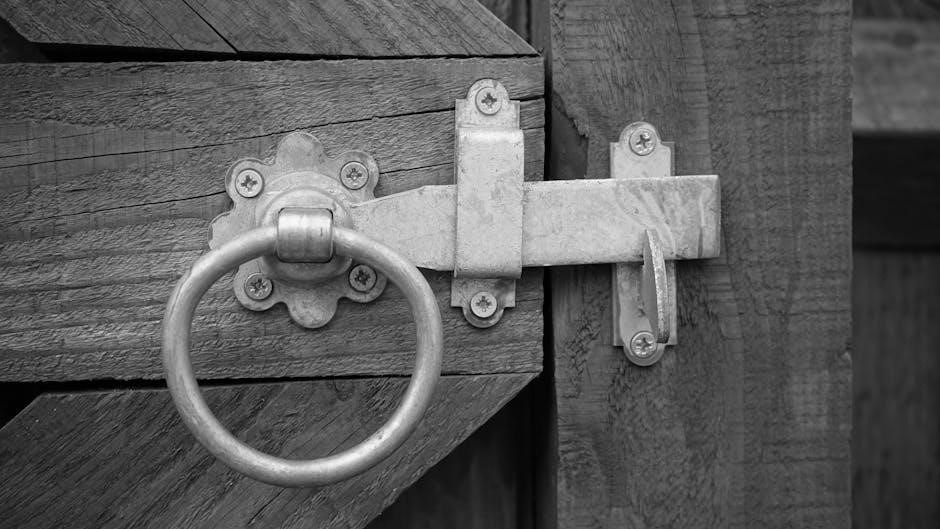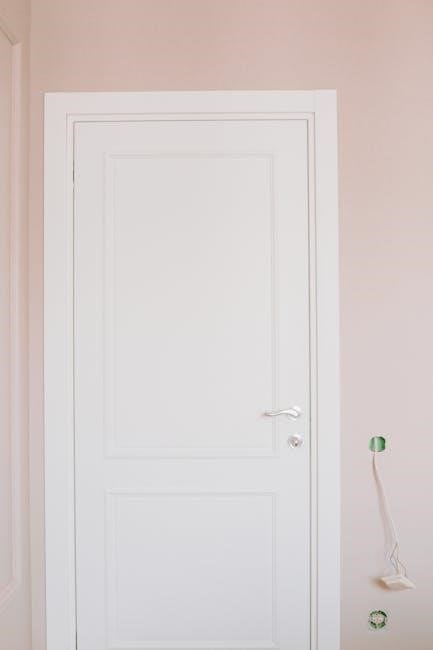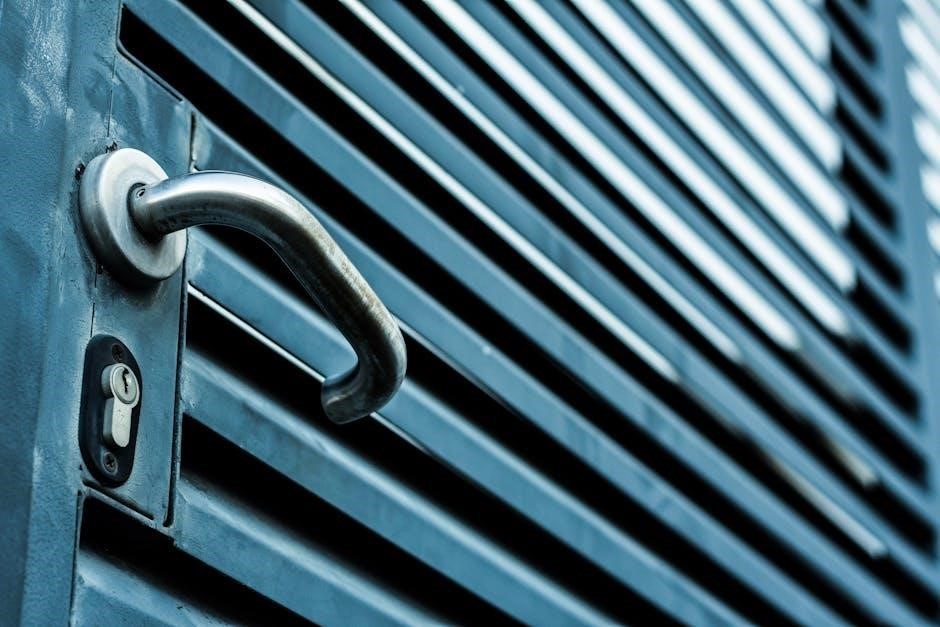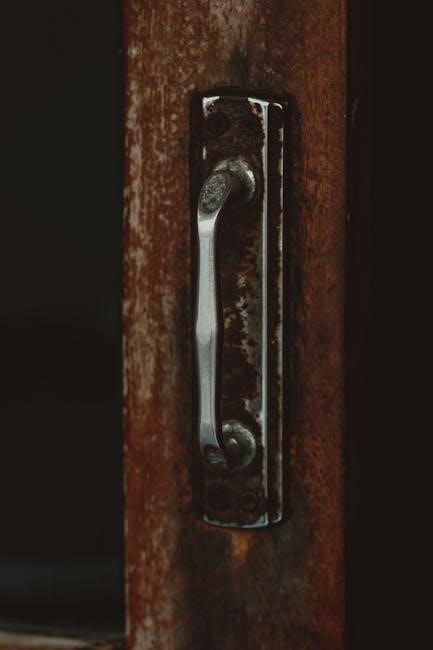Manual door locks are mechanical devices designed to secure doors‚ ensuring safety and privacy․ They remain a cornerstone of home security systems due to their reliability and simplicity‚ offering a robust barrier against unauthorized access while being easy to install and maintain․ These locks come in various styles‚ each tailored to specific needs‚ making them a versatile and essential component in protecting residential and commercial spaces․
Definition and Purpose of Manual Door Locks
Manual door locks are mechanical or electromechanical devices designed to secure doors‚ ensuring safety‚ privacy‚ and controlled access․ Their primary purpose is to prevent unauthorized entry while allowing easy operation for authorized individuals․ These locks function through a system of levers‚ bolts‚ and keys‚ requiring physical interaction to engage or disengage․ Unlike electronic locks‚ manual door locks rely on tangible mechanisms‚ making them durable and less prone to technological failures․ They are widely used in residential‚ commercial‚ and industrial settings due to their simplicity‚ reliability‚ and cost-effectiveness․ By providing a physical barrier‚ manual locks play a crucial role in safeguarding property and enhancing overall security systems․
Importance of Manual Door Locks in Home Security
Manual door locks are a cornerstone of home security‚ offering a reliable and straightforward method to safeguard properties․ Their robust design provides a strong physical barrier against potential intruders‚ enhancing safety and privacy․ Unlike electronic locks‚ manual locks are not vulnerable to technological malfunctions or power outages‚ making them highly durable and dependable․ They are cost-effective and require minimal maintenance‚ ensuring long-term reliability․ Additionally‚ manual locks are user-friendly‚ with intuitive mechanisms that provide peace of mind for homeowners․ Their simplicity and effectiveness make them a practical choice for securing doors in various settings‚ from residential homes to commercial spaces․ By serving as a primary defense mechanism‚ manual door locks play a vital role in protecting valuables and ensuring the well-being of occupants․

History and Evolution of Manual Door Locks
Manual door locks have evolved over centuries‚ from ancient wooden mechanisms to modern metallic designs․ Early locks used simple ward systems‚ while later innovations introduced pin tumblers and deadlock technologies‚ enhancing security and durability․
Ancient Locks and Their Mechanisms
Ancient Locks and Their Mechanisms
Ancient locks date back to around 2000 BCE‚ with early examples found in Egypt and Assyria․ These primitive locks were made of wood and used a simple mechanism involving a wooden bolt secured by a rope․ The first known mechanical lock was the Egyptian pin tumbler lock‚ where a key lifted pins to unlock the door․ Similarly‚ ancient Romans developed more sophisticated locks using iron and bronze‚ incorporating wards (internal obstacles) that required a specific key shape to turn․ These early designs laid the foundation for modern locking systems‚ demonstrating ingenuity and a focus on security․ Despite their simplicity‚ ancient locks were effective for their time‚ protecting valuable assets and marking the beginning of lock evolution․
Modern Developments in Manual Lock Technology
Modern manual door locks have evolved significantly‚ incorporating advanced materials and mechanisms for enhanced security․ One key innovation is the pin tumbler lock‚ perfected by Linus Yale in the 19th century‚ which remains widely used today․ Contemporary locks often feature anti-pick pins‚ reinforced strike plates‚ and hardened steel components to resist tampering․ Additionally‚ smart integration has been introduced‚ with manual locks incorporating biometric or digital key compatibility․ These locks also prioritize durability‚ using corrosion-resistant materials like stainless steel․ Energy-efficient designs and accessibility features‚ such as ergonomic levers‚ cater to diverse user needs․ Modern manual locks strike a balance between traditional reliability and cutting-edge security‚ ensuring they remain a vital component of home and commercial safety systems․

Types of Manual Door Locks
Manual door locks are categorized into deadbolt locks‚ doorknob locks‚ lever handle locks‚ and padlocks‚ each offering distinct security features tailored to various applications and preferences․
Deadbolt Locks
Deadbolt locks are among the most secure types of manual door locks‚ known for their robust mechanism․ They operate by extending a solid metal bolt into the door frame‚ ensuring enhanced resistance against forced entry․ Unlike spring-loaded locks‚ deadbolts require manual activation‚ typically via a key or thumb turn‚ making them highly reliable․ Available in single-cylinder and double-cylinder models‚ they offer flexibility for different security needs․ Single-cylinder deadbolts can be opened from one side with a key and the other with a thumb turn‚ while double-cylinder models require a key on both sides‚ adding an extra layer of safety․ Deadbolts are widely recommended for external doors‚ providing a strong defense against break-ins and tampering․ Their durability and effectiveness make them a preferred choice for homeowners seeking superior security solutions․ Regular maintenance‚ such as lubricating the lock mechanism and ensuring proper alignment‚ is essential to maintain their functionality and longevity․ Deadbolts are a testament to the evolution of manual locking systems‚ blending traditional mechanics with modern security demands․
Doorknob Locks
Doorknob locks are a common and versatile type of manual door lock‚ offering both convenience and security․ They feature a rotating handle and an integrated locking mechanism‚ often with a keyway for added protection․ These locks are widely used in residential settings due to their ease of use and aesthetic appeal․ Doorknob locks come in various finishes and styles‚ making them a popular choice for interior and exterior doors․ While they provide a basic level of security‚ they are generally considered less secure than deadbolt locks‚ as the mechanism can be vulnerable to forced entry․ For enhanced safety‚ they are often paired with deadbolts․ Regular maintenance‚ such as lubricating the lock and handle‚ ensures smooth operation and longevity․ Doorknob locks remain a practical and affordable option for everyday use․
Lever Handle Locks
Lever handle locks are a popular type of manual door lock known for their ease of use and accessibility․ They feature a horizontal lever that‚ when pressed‚ activates the locking mechanism․ These locks are often preferred in commercial settings due to their durability and ease of operation‚ making them ideal for high-traffic areas․ Lever handle locks are also a practical choice for individuals with mobility challenges‚ as they require less grip strength compared to traditional doorknob locks․ Available in various designs and finishes‚ they can complement both modern and traditional decor․ While they provide reliable security‚ they are typically used in conjunction with other locking systems for enhanced protection․ Regular maintenance ensures smooth functionality and extends their lifespan․ Lever handle locks strike a balance between functionality and aesthetics‚ making them a versatile option for many applications․

Padlocks
Padlocks are versatile and portable manual locks used to secure a wide range of items‚ from gates and storage units to luggage and equipment․ Unlike built-in locks‚ padlocks are not permanently attached to doors or objects‚ offering flexibility in their application․ They typically consist of a shackle that can be passed through a hasp or other fastening point‚ with a locking mechanism that can be operated by a key or combination․ Padlocks vary in size‚ material‚ and security level‚ making them suitable for both light-duty and high-security needs․ Their portability and ease of use make them a popular choice for temporary or additional security measures․ Regular maintenance‚ such as lubricating the locking mechanism‚ ensures smooth operation and longevity․ Padlocks are a practical solution for securing valuables in various settings․

Installation and Maintenance
Proper installation ensures smooth operation‚ while regular maintenance‚ like lubricating moving parts and inspecting alignment‚ keeps manual locks functional and secure over time․
Step-by-Step Installation Guide
Begin by preparing the tools and materials‚ such as a drill‚ screws‚ and the lockset․ Measure the door to ensure correct alignment for the lock’s components․ Mark the door and frame where the lock and strike plate will be installed․ Drill pilot holes for screws‚ then secure the lockset and strike plate․ Align the latchbolt with the strike plate to ensure smooth operation․ Tighten all screws firmly․ Test the lock by turning the key or handle to confirm it engages and disengages properly․ Finally‚ check the door’s overall alignment and adjust if necessary for optimal security and functionality․

Regular Maintenance Tips
To ensure optimal performance‚ manual door locks require consistent upkeep․ Start by lubricating the lock’s internal mechanisms with a silicone-based spray to prevent rust and friction․ Regularly inspect and tighten any loose screws to maintain stability․ Clean the keyway and interior with a small brush or soft cloth to remove dust and debris․ Check the door alignment with the frame and adjust if necessary for smooth locking․ Inspect the strike plate; if misaligned‚ reposition or replace it․ Test the lock frequently to ensure proper function․ Finally‚ address any worn-out parts promptly to maintain security and longevity․
Troubleshooting Common Issues
Manual door locks can occasionally encounter issues that hinder their functionality․ A common problem is the key failing to turn‚ often due to dirt or debris in the keyway․ Cleaning the keyway with a soft brush or compressed air can resolve this․ Another issue is the door not aligning properly with the frame‚ causing the lock to malfunction․ Adjusting the door hinges or strike plate can fix this misalignment․ If the lock sticks or is hard to operate‚ lubricating the internal mechanisms with a silicone-based spray can restore smooth operation․ Addressing these problems promptly ensures the lock remains secure and functional‚ preventing larger issues from developing over time․

Security Features and Considerations
Manual door locks offer robust security features‚ including tamper-resistant designs and durable materials․ Regular maintenance and proper installation are crucial to ensure optimal performance and reliability․
Advantages of Manual Locks Over Electronic Locks
Manual door locks offer several advantages over electronic locks‚ primarily in reliability and simplicity․ They require no electricity‚ eliminating vulnerabilities from power outages or battery failures․ With fewer mechanical components‚ manual locks are less prone to technical issues‚ ensuring consistent functionality․ Additionally‚ they are cost-effective‚ both in installation and maintenance‚ making them a practical choice for many homeowners․ Their straightforward design also enhances security‚ as they lack the potential hacking risks associated with smart locks․ Moreover‚ manual locks are easier to repair and replace‚ reducing long-term maintenance costs․ Overall‚ they provide a durable‚ low-maintenance solution for securing doors without compromising on safety or convenience․

Common Threats and How to Mitigate Them

Manual door locks are susceptible to threats like picking‚ bumping‚ and forced entry․ To mitigate these risks‚ use high-quality locks with anti-pick and anti-bump pins‚ which make tampering difficult․ Regular maintenance ensures optimal functionality‚ while reinforcing the door frame and strike plate enhances resistance to forced entry․ Additionally‚ combining manual locks with secondary security measures‚ such as deadbolts or padlocks‚ significantly improves overall safety․ Educating users about proper locking techniques and the importance of securing keys also plays a crucial role in preventing unauthorized access․ By addressing these vulnerabilities‚ manual locks can provide robust security for homes and businesses‚ ensuring lasting protection against potential threats․
